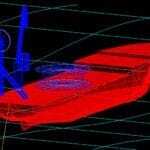STA BOTSTAB – On-Bottom Stability of Submarine Pipelines
STA BOTSTAB has contains curve-fit equations and interpolation methods that remove the need for constantly looking up information in RP-E306. The pipe weight required for an absolutely stable pipe is given by STA BOTSTAB.
In 2007 DNV introduced “Recommended Practice DNV-RP-F109, ON-BOTTOM STABILITY DESIGN OF SUBMARINE PIPELINES” which replaces E306. STA has implemented parts of the Generalized Lateral Stability Analysis method from F109 and incorporated them into STA BOTSTAB2.
View STA BOTSTAB Technical Note.

In the figure above, the predicted weight for a stable pipe is 1269 lbf/ft, or 1888 kgf/m. The input pipe weight is 641 lbf/ft. Hence the program warns that the pipe is not stable in this analysis. The significant wave height is 32.8
feet and the water depth is 108 feet. A JONSWAP spectrum is used with gamma = 3.3 and Tp = 13 seconds. No wave spreading has been specified and the wave direction is 0 degrees, which is perpendicular to the pipe. A
current velocity of 1 knot has been specified, perpendicular to the pipe at an elevation of 16.4 feet above the sea bed. Lift, drag and inertia force coefficients have been specified in accordance with recommendations in
E305. A friction coefficient is also given and the sea bed has been selected to be medium sand.

Figure 2 shows the results for the same input data, but using the generalized method from F109, and for the case of a sand sea bed. In this case the pipe weight required for a stable pipe is 1294 lbf/ft, almost exactly the same as in the E305 results. The weight required for an L10 pipe (that limits the lateral displacement to 10 pipe diameters) is predicted to be just 633 lbf/ft.
The results in Figure 2 for clay are provided with the caution that the clay calculations have not yet been fully tested.
The following figures show screen captures of the dialog boxes that are displayed when the user clicks various buttons on the main screen.


We use STA BOTSTAB for calculating the on-bottom stability of submarine pipelines, flowlines, umbilicals, hoses and cables. In 2018 we performed extensive runs for a submarine hose being developed for the US Navy for rapid development of ship-to-shore liquid deliveries.


